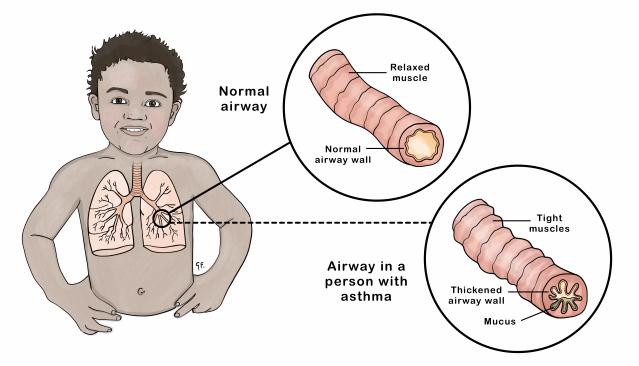Asthma interval symptoms animation
Find out what asthma interval symptoms are and how to manage them.
Source: KidsHealth
transcribeTranscript
Asthma is a condition that leads to narrowing of the airways of the lungs.
Some tamariki get asthma symptoms between asthma attacks.
These are called interval symptoms.
[Cough]
Tamariki can have interval symptoms a couple of times a week, or as much as every day.
Interval symptoms are different from an asthma attack.
Interval symptoms include:
- coughing at night [coughing]
- wheezing or coughing with exercise [wheezing]
- feeling breathless [breathing sounds]
- having trouble keeping up with other tamariki during activity
- needing to use a reliever inhaler more than twice a week
If your child has interval symptoms, see your health professional.
Your child may need a change in their asthma management. This may be adding or changing an asthma medicine.
Ask for an up-to-date asthma action plan.
An asthma action plan helps you to know what medicines to use and when.
This is for their day-to-day symptoms as well as during an asthma attack.
It also helps you to know when to seek help or call an ambulance.
Good management can stop asthma from interfering with your child's life, including enjoyment of sports and play.
Key points about asthma interval symptoms
- interval symptoms are asthma symptoms that happen between asthma attacks
- interval symptoms include breathlessness, coughing at night, and wheezing or coughing with exercise
- needing to use a reliever inhaler more than twice a week may also mean your child has interval symptoms
- ask your child's health professional for an asthma action plan to help manage their interval symptoms
- tamariki and rangatahi with interval symptoms may need a change in their asthma treatment

What are interval symptoms?
Many tamariki and rangatahi get no symptoms between asthma attacks. But, some tamariki get asthma symptoms between asthma attacks. These symptoms are called interval symptoms.
Some tamariki may have interval symptoms a couple of times a week, or as much as every day. If your child has interval symptoms, they may need a daily preventer inhaler. Or, they may need an increase or a change in their asthma treatment. Talk to your health professional.
Learn more about asthma.
Signs of interval symptoms
Signs that your child has interval symptoms include:
- coughing at night
- wheezing or coughing with exercise
- feeling breathless
- needing to use a reliever inhaler more than twice a week
Causes of asthma interval symptoms
Interval symptoms are caused by inflammation in the airways of the lungs. This inflammation leads to narrowing of the airways. Things that can trigger interval symptoms include activity and cold or damp air.
How interval symptoms are different from other asthma symptoms
There are 2 types of asthma symptoms - those that happen during an asthma attack and those that happen between asthma attacks. Interval symptoms are the symptoms that happen between asthma attacks.
During an asthma attack, your child’s symptoms will be worse.
What to do if your child is having frequent interval symptoms
If your child has lots of interval symptoms, they may need a daily preventer inhaler. Or they may need an increase or a change in their asthma treatment. Talk to your health professional.
If your child has very few or no interval symptoms, this is a good sign that their asthma treatment is working well.
How to improve interval symptoms
Asthma action plan
The best way to improve interval symptoms is to make sure your child has a good asthma action plan. Ask your child's health professional for an asthma action plan. This will be specific to your child.
Having an asthma action plan means you can be confident to use the medicines your child needs for their asthma. This is both for their day-to-day symptoms as well as during an asthma attack. It’s a good idea to review the asthma plan every year.

Take a look at the Asthma and Respiratory Foundation website for an example of what a blank asthma plan looks like (it's available in English, te reo Māori, Samoan and Tongan).
Good spacer technique
Having good spacer technique is important. Using a spacer helps direct the medicine into your child's lungs, where it can work best.
Other asthma treatments
Your health professional may prescribe other medicines, including dry powder inhalers or tablets to help your child’s asthma.
Acknowledgements
Illustration by Dr Greta File. Property of KidsHealth.
